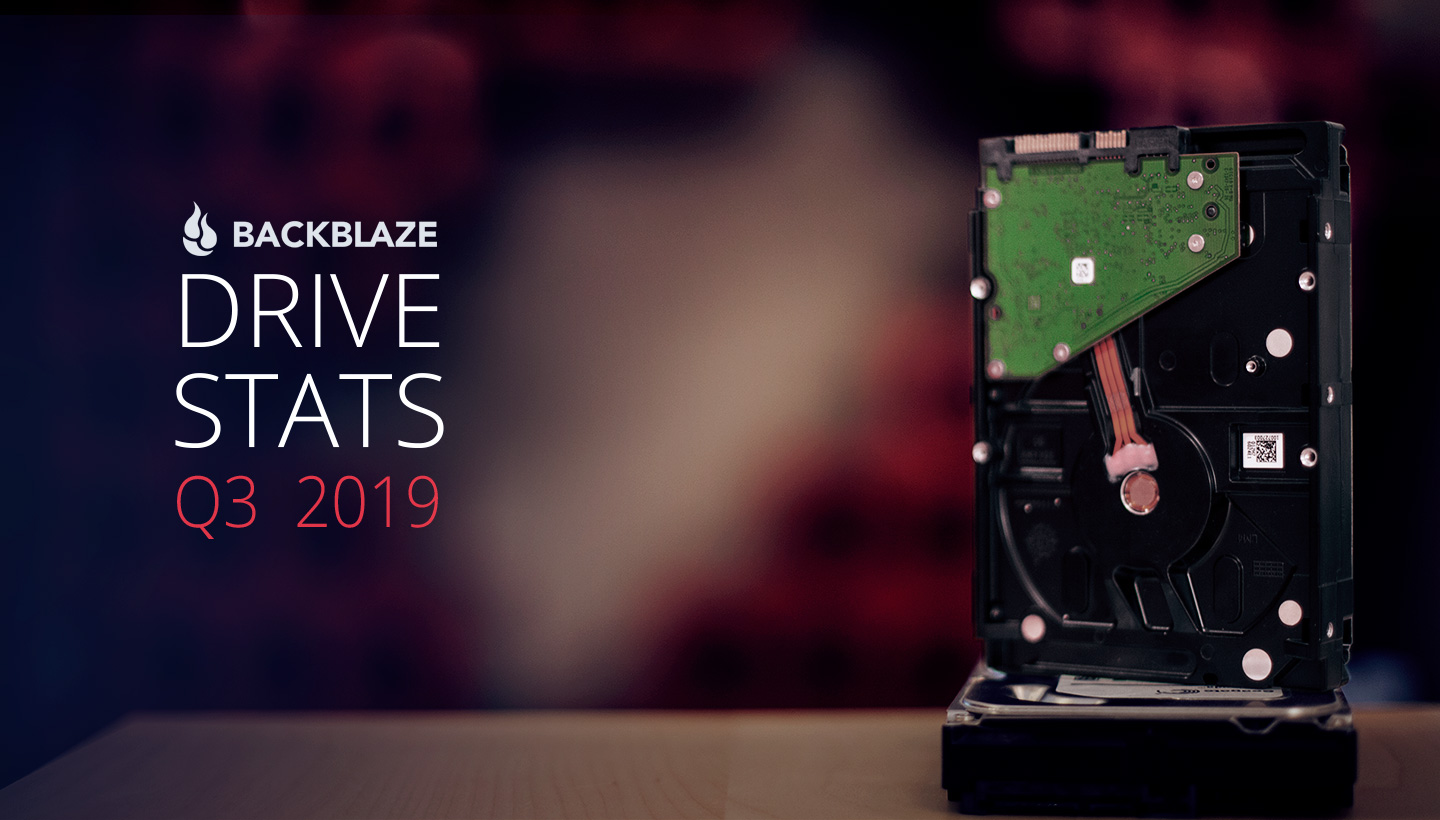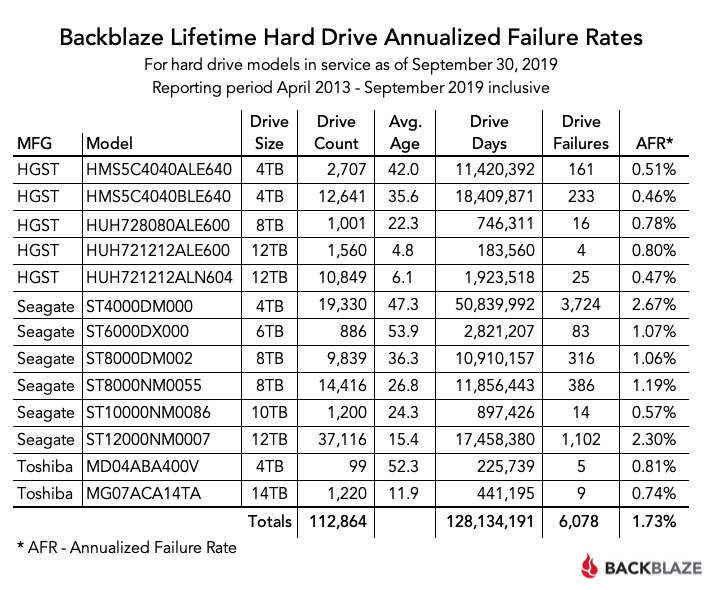
As of September 30, 2019, Backblaze had 115,151 spinning hard drives spread across four data centers on two continents. Of that number, there were 2,098 boot drives and 113,053 data drives. We’ll look at the lifetime hard drive failure rates of the data drive models currently in operation in our data centers, but first we’ll cover the events that occurred in Q3 that potentially affected the drive stats for that period. As always, we’ll publish the data we use in these reports on our Hard Drive Test Data web page and we look forward to your comments.
Hard Drive Stats for Q3 2019
At this point in prior hard drive stats reports we would reveal the quarterly hard drive stats table. This time we are only going to present the Lifetime Hard Drive Failure table, which you can see if you jump to the end of this report. For the Q3 table, the data which we typically use to create that report may have been indirectly affected by one of our utility programs which performs data integrity checks. While we don’t believe the long-term data is impacted, we felt you should know. Below, we will dig into the particulars in an attempt to explain what happened in Q3 and what we think it all means.
What is a Drive Failure?
Over the years we have stated that a drive failure occurs when a drive stops spinning, won’t stay as a member of a RAID array, or demonstrates continuous degradation over time as informed by SMART stats and other system checks. For example, a drive that reports a rapidly increasing or egregious number of media read errors is a candidate for being replaced as a failed drive. These types of errors are usually seen in the SMART stats we record as non-zero values for SMART 197 and 198 which log the discovery and correctability of bad disk sectors, typically due to media errors. We monitor other SMART stats as well, but these two are the most relevant to this discussion.
What might not be obvious is that changes in some SMART attributes only occur when specific actions occur. Using SMART 197 and 198 as examples again, these values are only affected when a read or write operation occurs on a disk sector whose media is damaged or otherwise won’t allow the operation. In short, SMART stats 197 and 198 that have a value of zero today will not change unless a bad sector is encountered during normal disk operations. These two SMART stats don’t cause read and writes to occur, they only log aberrant behavior from those operations.
Protecting Stored Data
When a file, or group of files, arrives at a Backblaze data center, the file is divided into pieces we call shards. For more information on how shards are created and used in the Backblaze architecture, please refer to Backblaze Vault and Backblaze Erasure Coding blog posts. For simplicity’s sake, let’s say a shard is a blob of data that resides on a disk in our system.
As each shard is stored on a hard drive, we create and store a one-way hash of the contents. For reasons ranging from media damage to bit rot to gamma rays, we check the integrity of these shards regularly by recomputing the hash and comparing it to the stored value. To recompute the shard hash value, a utility known as a shard integrity check reads the data in the shard. If there is an inconsistency between the newly computed and the stored hash values, we rebuild the shard using the other shards as described in the Backblaze Vault blog post.
Shard Integrity Checks
The shard integrity check utility runs as a utility task on each Storage Pod. In late June, we decided to increase the rate of the shard integrity checks across the data farm to cause the checks to run as often as possible on a given drive while still maintaining the drive’s performance. We increased the frequency of the shard integrity checks to account for the growing number of larger-capacity drives that had been deployed recently.
The Consequences for Drive Stats
Once we write data to a disk, that section of disk remains untouched until the data is read by the user, the data is read by the shard integrity check process to recompute the hash, or the data is deleted and written over. As a consequence, there are no updates regarding that section of disk sent to SMART stats until one of those three actions occur. By speeding up the frequency of the shard integrity checks on a disk, the disk is read more often. Errors discovered during the read operation of the shard integrity check utility are captured by the appropriate SMART attributes. Putting together the pieces, a problem that would have been discovered in the future—under our previous shard integrity check cadence—would now be captured by the SMART stats when the process reads that section of disk today.
By increasing the shard integrity check rate, we potentially moved failures that were going to be found in the future into Q3. While discovering potential problems earlier is a good thing, it is possible that the hard drive failures recorded in Q3 could then be artificially high as future failures were dragged forward into the quarter. Given that our Annualized Failure Rate calculation is based on Drive Days and Drive Failures, potentially moving up some number of failures into Q3 could cause an artificial spike in the Q3 Annualized Failure Rates. This is what we will be monitoring over the coming quarters.
There are a couple of things to note as we consider the effect of the accelerated shard integrity checks on the Q3 data for Drive Stats:
- The number of drive failures over the lifetime of a given drive model should not increase. At best we just moved the failures around a bit.
- It is possible that the shard integrity checks did nothing to increase the number of drive failures that occurred in Q3. The quarterly failure rates didn’t vary wildly from previous quarters, but we didn’t feel comfortable publishing them at this time given the discussion above.
Lifetime Hard Drive Stats through Q3 2019
Below are the lifetime failure rates for all of our drive models in service as of September 30, 2019.

The lifetime failure rate for the drive models in production rose slightly, from 1.70% at the end of Q2 to 1.73% at the end of Q3. This trivial increase would seem to indicate that the effect of the potential Q3 data issue noted above is minimal and well within a normal variation. However, we’re not satisfied that is true yet and we have a plan for making sure as we’ll see in the next section.
What’s Next for Drive Stats?
We will continue to publish our Hard Drive Stats each quarter, and next quarter we expect to include the quarterly (Q4) chart as well. For the foreseeable future, we will have a little extra work to do internally as we will be tracking two different groups of drives. One group will be the drives that “went through the wormhole,” so to speak, as they were present during the accelerated shard integrity checks. The other group will be those drives that were placed into production after the shard integrity check setting was reduced. We’ll compare these two datasets to see if there was indeed any effect of the increased shard integrity checks on the Q3 hard drive failure rates. We’ll let you know what we find in subsequent drive stats reports.
The Hard Drive Stats Data
The complete data set used to create the information used in this review is available on our Hard Drive Test Data web page. You can download and use this data for free for your own purpose. All we ask are three things: 1) You cite Backblaze as the source if you use the data, 2) You accept that you are solely responsible for how you use the data, and, 3) You do not sell this data to anyone; it is free. Good luck and let us know what you find.
As always, we look forward to your thoughts and questions in the comments.













 The STEMs of Backblaze: How We Got Here
The STEMs of Backblaze: How We Got Here